Optimizing Subtalar Arthrodesis: A Human Cadaveric Evaluation of a Novel Partially-Threaded Screw Combination in the Delta Configuration
Abstract
1. Introduction
2. Materials and Methods
2.1. Specimens and Preparation
2.2. Biomechanical Testing
2.3. Data Acquisition and Evaluation
3. Results
3.1. Initial Stiffness
3.2. Talus–Calcaneus Movements
3.3. Cycles to Failure
3.4. Modes of Failure
4. Discussion
5. Conclusions
Author Contributions
Funding
Informed Consent Statement
Data Availability Statement
Acknowledgments
Conflicts of Interest
References
- Vulcano, E.; Ellington, J.K.; Myerson, M.S. The Spectrum of Indications for Subtalar Joint Arthrodesis. Foot Ankle Clin. 2015, 20, 293–310. [Google Scholar] [CrossRef]
- Jastifer, J.R.; Alrafeek, S.; Howard, P.; Gustafson, P.A.; Coughlin, M.J. Biomechanical Evaluation of Strength and Stiffness of Subtalar Joint Arthrodesis Screw Constructs. Foot Ankle Int. 2016, 37, 419–426. [Google Scholar] [CrossRef] [PubMed]
- Haskell, A.; Pfeiff, C.; Mann, R. Subtalar Joint Arthrodesis Using a Single Lag Screw. Foot Ankle Int. 2004, 25, 774–777. [Google Scholar] [CrossRef] [PubMed]
- Perisano, C.; Cannella, A.; Polichetti, C.; Mascio, A.; Comisi, C.; De Santis, V.; Caravelli, S.; Mosca, M.; Spedicato, G.A.; Maccauro, G.; et al. Tibiotalar and Tibiotalocalcaneal Arthrodesis with Paragon28 SilverbackTM Plating System in Patients with Severe Ankle and Hindfoot Deformity. Medicina 2023, 59, 344. [Google Scholar] [CrossRef] [PubMed]
- Chahal, J.; Stephen, D.J.G.; Bulmer, B.; Daniels, T.; Kreder, H.J. Factors Associated With Outcome After Subtalar Arthrodesis. J. Orthop. Trauma 2006, 20, 555–561. [Google Scholar] [CrossRef] [PubMed]
- Hungerer, S.; Trapp, O.; Augat, P.; Bühren, V. Posttraumatic Arthrodesis of the Subtalar Joint—Outcome in Workers Compensation and Rates of Non-Union. Foot Ankle Surg. 2011, 17, 277–283. [Google Scholar] [CrossRef] [PubMed]
- Tuijthof, G.J.M.; Beimers, L.; Kerkhoffs, G.M.M.J.; Dankelman, J.; Dijk, C.N. van Overview of Subtalar Arthrodesis Techniques: Options, Pitfalls and Solutions. Foot Ankle Surg. 2010, 16, 107–116. [Google Scholar] [CrossRef] [PubMed]
- Kang, S.-W.; Jung, S.W.; Woo, S.H. Factors Associated with Nonunion of the Posttraumatic Subtalar Arthrodesis after Displaced Intra-Articular Calcaneal Fractures. Foot Ankle Surg. 2023, 29, 188–194. [Google Scholar] [CrossRef] [PubMed]
- Kim, H.N.; Choi, Y.R.; Kim, B.S.; Kim, Y.M.; Lee, J.; Cho, J.H.; Cha, S.; Park, J.Y. Factors Influencing Successful Bone Union of Isolated Subtalar Arthrodesis for Posttraumatic Subtalar Arthritis: A Multicenter Case Series. J. Orthop. Surg. 2023, 18, 559. [Google Scholar] [CrossRef] [PubMed]
- Easley, M.E.; Trnka, H.J.; Schon, L.C.; Myerson, M.S. Isolated Subtalar Arthrodesis. J. Bone Jt. Surg. Am. 2000, 82, 613–624. [Google Scholar] [CrossRef]
- Wirth, S.H.; Viehöfer, A.; Fritz, Y.; Zimmermann, S.M.; Rigling, D.; Urbanschitz, L. How Many Screws Are Necessary for Subtalar Fusion? A Retrospective Study. Foot Ankle Surg. 2020, 26, 699–702. [Google Scholar] [CrossRef] [PubMed]
- Ziegler, P.; Friederichs, J.; Hungerer, S. Fusion of the Subtalar Joint for Post-Traumatic Arthrosis: A Study of Functional Outcomes and Non-Unions. Int. Orthop. 2017, 41, 1387–1393. [Google Scholar] [CrossRef] [PubMed]
- Riedl, M.; Glisson, R.R.; Matsumoto, T.; Hofstaetter, S.G.; Easley, M.E. Torsional Stiffness after Subtalar Arthrodesis Using Second Generation Headless Compression Screws: Biomechanical Comparison of 2-Screw and 3-Screw Fixation. Clin. Biomech. 2017, 45, 32–37. [Google Scholar] [CrossRef] [PubMed]
- Thaunat, M.; Bajard, X.; Boisrenoult, P.; Beaufils, P.; Oger, P. Computer Tomography Assessment of the Fusion Rate after Posterior Arthroscopic Subtalar Arthrodesis. Int. Orthop. 2012, 36, 1005–1010. [Google Scholar] [CrossRef]
- Eichinger, M.; Schmölz, W.; Brunner, A.; Mayr, R.; Bölderl, A. Subtalar Arthrodesis Stabilisation with Screws in an Angulated Configuration Is Superior to the Parallel Disposition: A Biomechanical Study. Int. Orthop. 2015, 39, 2275–2280. [Google Scholar] [CrossRef] [PubMed]
- Hungerer, S.; Eberle, S.; Lochner, S.; Maier, M.; Högel, F.; Penzkofer, R.; Augat, P. Biomechanical Evaluation of Subtalar Fusion: The Influence of Screw Configuration and Placement. J. Foot Ankle Surg. 2013, 52, 177–183. [Google Scholar] [CrossRef]
- Hintermann, B.; Valderrabano, V.; Nigg, B. Influence of Screw Type on Obtained Contact Area and Contact Force in a Cadaveric Subtalar Arthrodesis Model. Foot Ankle Int. 2002, 23, 986–991. [Google Scholar] [CrossRef] [PubMed]
- Bailey, E.; Hoch, C.P.; Goodloe, J.B.; Scott, D.J.; Gross, C.E. Increased Complication and Hardware Removal Rates with Headed Screws in Ankle or Subtalar Arthrodesis. Foot Ankle Orthop. 2022, 7, 2473011421S00518. [Google Scholar] [CrossRef]
- Kunzler, D.; Shazadeh Safavi, P.; Jupiter, D.; Panchbhavi, V. A Comparison of Removal Rates of Headless Screws versus Headed Screws in Calcaneal Osteotomy. Foot Ankle Spec. 2018, 11, 420–424. [Google Scholar] [CrossRef]
- Scanlan, R.L.; Burns, P.R.; Crim, B.E. Technique Tip: Subtalar Joint Fusion Using a Parallel Guide and Double Screw Fixation. J. Foot Ankle Surg. 2010, 49, 305–309. [Google Scholar] [CrossRef]
- Assari, S.; Darvish, K.; Ilyas, A.M. Biomechanical Analysis of Second-Generation Headless Compression Screws. Injury 2012, 43, 1159–1165. [Google Scholar] [CrossRef]
- Douthit, C.; Blue, M.; Wooldridge, A.; Lierly-Chick, M.; Gilbert, K.; Grimes, J. Comparison of Joint Compression and Pull- Out Strength of 6.5-Mm Self-Drilling Screws With Headed and Headless in Subtalar Arthrodesis: A Pilot Study. UNM Orthop. Res. J. 2019, 8, 27. [Google Scholar]
- Matsumoto, T.; Glisson, R.R.; Reidl, M.; Easley, M.E. Compressive Force with 2-Screw and 3-Screw Subtalar Joint Arthrodesis With Headless Compression Screws. Foot Ankle Int. 2016, 37, 1357–1363. [Google Scholar] [CrossRef]
- Sayres, S.C.; Gu, Y.; Kiernan, S.; DeSandis, B.A.; Elliott, A.J.; O’Malley, M.J. Comparison of Rates of Union and Hardware Removal between Large and Small Cannulated Screws for Calcaneal Osteotomy. Foot Ankle Int. 2015, 36, 32–36. [Google Scholar] [CrossRef]
- Bartoníček, J.; Rammelt, S.; Naňka, O. Anatomy of the Subtalar Joint. Foot Ankle Clin. 2018, 23, 315–340. [Google Scholar] [CrossRef]
- Ferrao, P.N.; Saragas, N.P.; Strydom, A. Isolated Subtalar Arthrodesis. JBJS Essent. Surg. Tech. 2016, 6, e12. [Google Scholar] [CrossRef]
- Patel, N.B.; Blazek, C.; Scanlan, R.; Manway, J.M.; Burns, P.R. Common Pitfalls in Subtalar Joint Preparation for Arthrodesis via Sinus Tarsi Approach. J. Foot Ankle Surg. 2020, 59, 253–257. [Google Scholar] [CrossRef]
- Jastifer, J.R.; Gustafson, P.A.; Gorman, R.R. Subtalar Arthrodesis Alignment: The Effect on Ankle Biomechanics. Foot Ankle Int. 2013, 34, 244–250. [Google Scholar] [CrossRef]
- Boffeli, T.J.; Reinking, R.R. A 2-Screw Fixation Technique for Subtalar Joint Fusion: A Retrospective Case Series Using a 2-Screw Fixation Construct with Operative Pearls. J. Foot Ankle Surg. 2012, 51, 734–738. [Google Scholar] [CrossRef]
- Chuckpaiwong, B.; Easley, M.E.; Glisson, R.R. Screw Placement in Subtalar Arthrodesis: A Biomechanical Study. Foot Ankle Int. 2009, 30, 133–141. [Google Scholar] [CrossRef]
- Battula, S.; Schoenfeld, A.J.; Sahai, V.; Vrabec, G.A.; Tank, J.; Njus, G.O. The Effect of Pilot Hole Size on the Insertion Torque and Pullout Strength of Self-Tapping Cortical Bone Screws in Osteoporotic Bone. J. Trauma Acute Care Surg. 2008, 64, 990. [Google Scholar] [CrossRef]
- Ivanov, S.; Stefanov, A.; Zderic, I.; Rodemund, C.; Schepers, T.; Gehweiler, D.; Dauwe, J.; Pastor, T.; Makelov, B.; Raykov, D.; et al. Percutaneous Fixation of Intraarticular Joint-Depression Calcaneal Fractures with Different Screw Configurations—A Biomechanical Human Cadaveric Analysis. Eur. J. Trauma Emerg. Surg. 2022, 48, 3305–3315. [Google Scholar] [CrossRef]
- Berk, T.; Zderic, I.; Schwarzenberg, P.; Pfeifer, R.; Pastor, T.; Halvachizadeh, S.; Richards, R.G.; Gueorguiev, B.; Pape, H.-C. Anterior Column Acetabulum Fracture Fixation with a Screw-Augmented Acetabular Cup-A Biomechanical Feasibility Study. Clin. Biomech. Bristol Avon 2023, 109, 106095. [Google Scholar] [CrossRef]
- Pastor, T.; Zderic, I.; Gehweiler, D.; Gardner, M.J.; Stoffel, K.; Richards, G.; Knobe, M.; Gueorguiev, B. Biomechanical Analysis of Recently Released Cephalomedullary Nails for Trochanteric Femoral Fracture Fixation in a Human Cadaveric Model. Arch. Orthop. Trauma Surg. 2022, 142, 3787–3796. [Google Scholar] [CrossRef]
- Chraim, M.; Recheis, S.; Alrabai, H.; Wenzel-Schwarz, F.; Trnka, H.-J.; Bock, P. Midterm Outcome of Subtalar Joint Revision Arthrodesis. Foot Ankle Int. 2021, 42, 824–832. [Google Scholar] [CrossRef]
- Johnson, N.L.; Galuppo, L.D.; Stover, S.M.; Taylor, K.T. An In Vitro Biomechanical Comparison of the Insertion Variables and Pullout Mechanical Properties of AO 6.5-Mm Standard Cancellous and 7.3-Mm Self-Tapping, Cannulated Bone Screws in Foal Femoral Bone. Vet. Surg. 2004, 33, 691–698. [Google Scholar] [CrossRef]
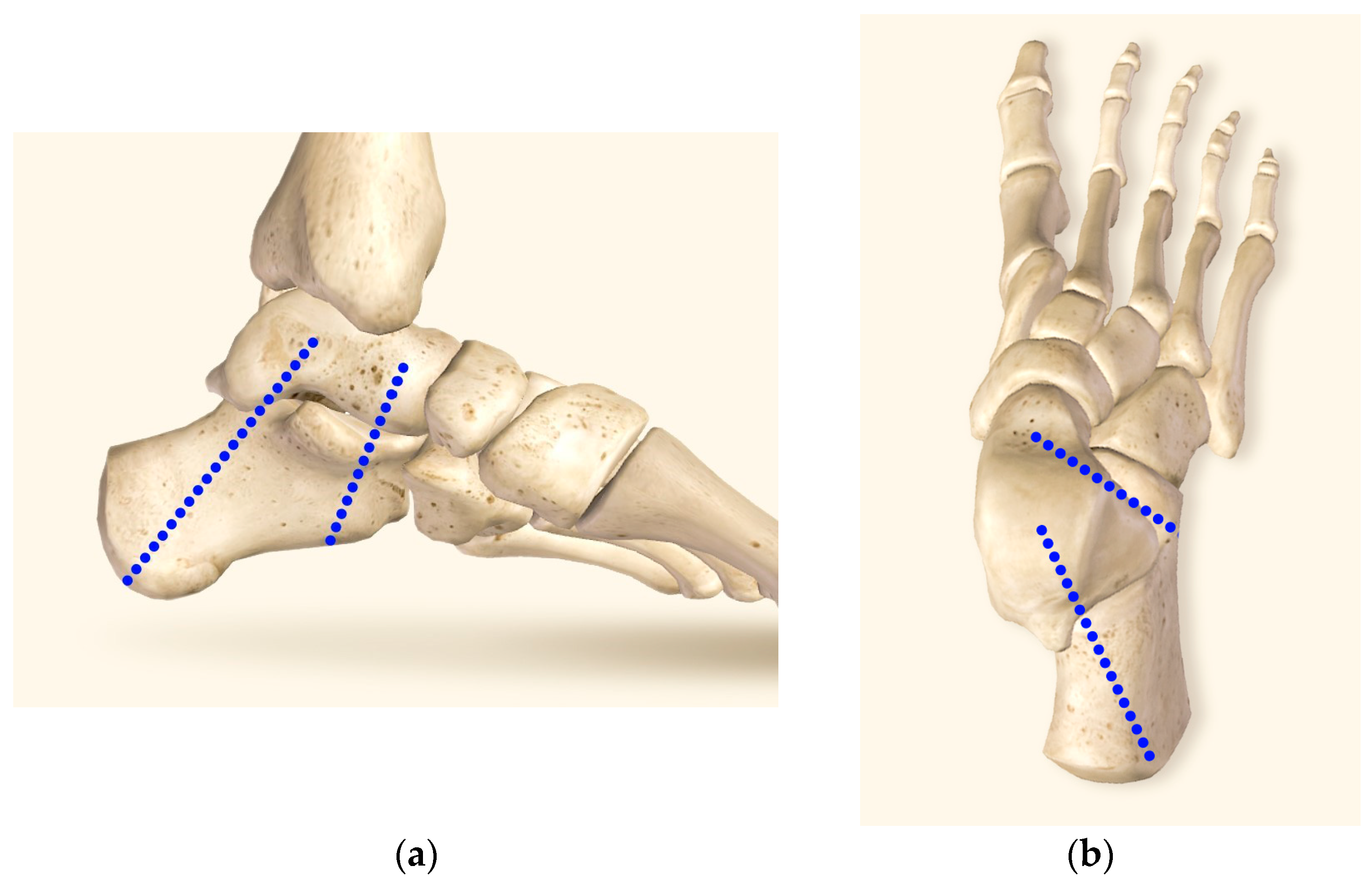
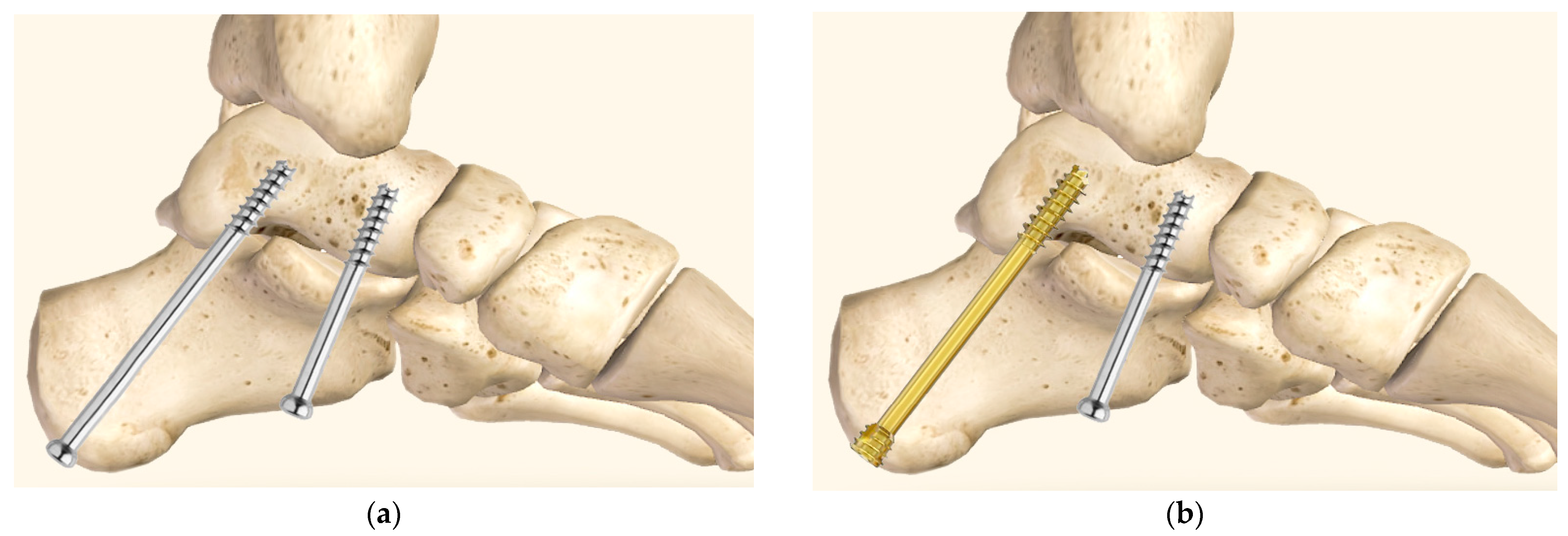
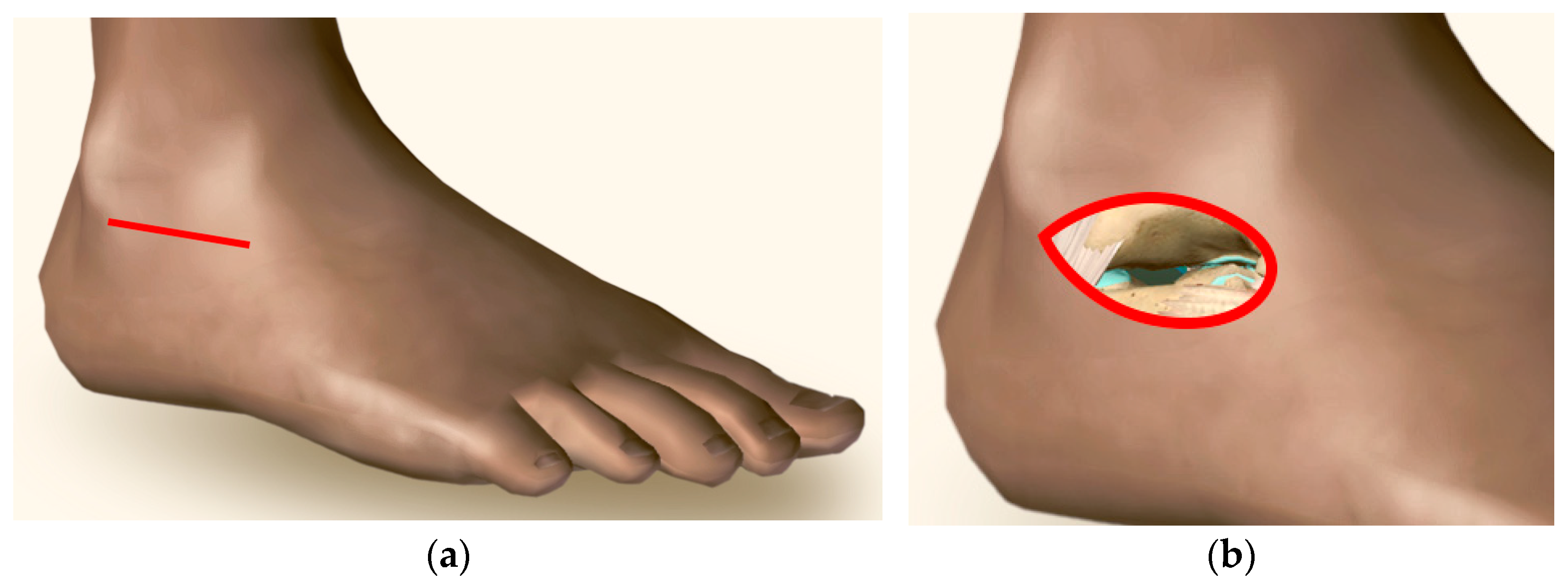
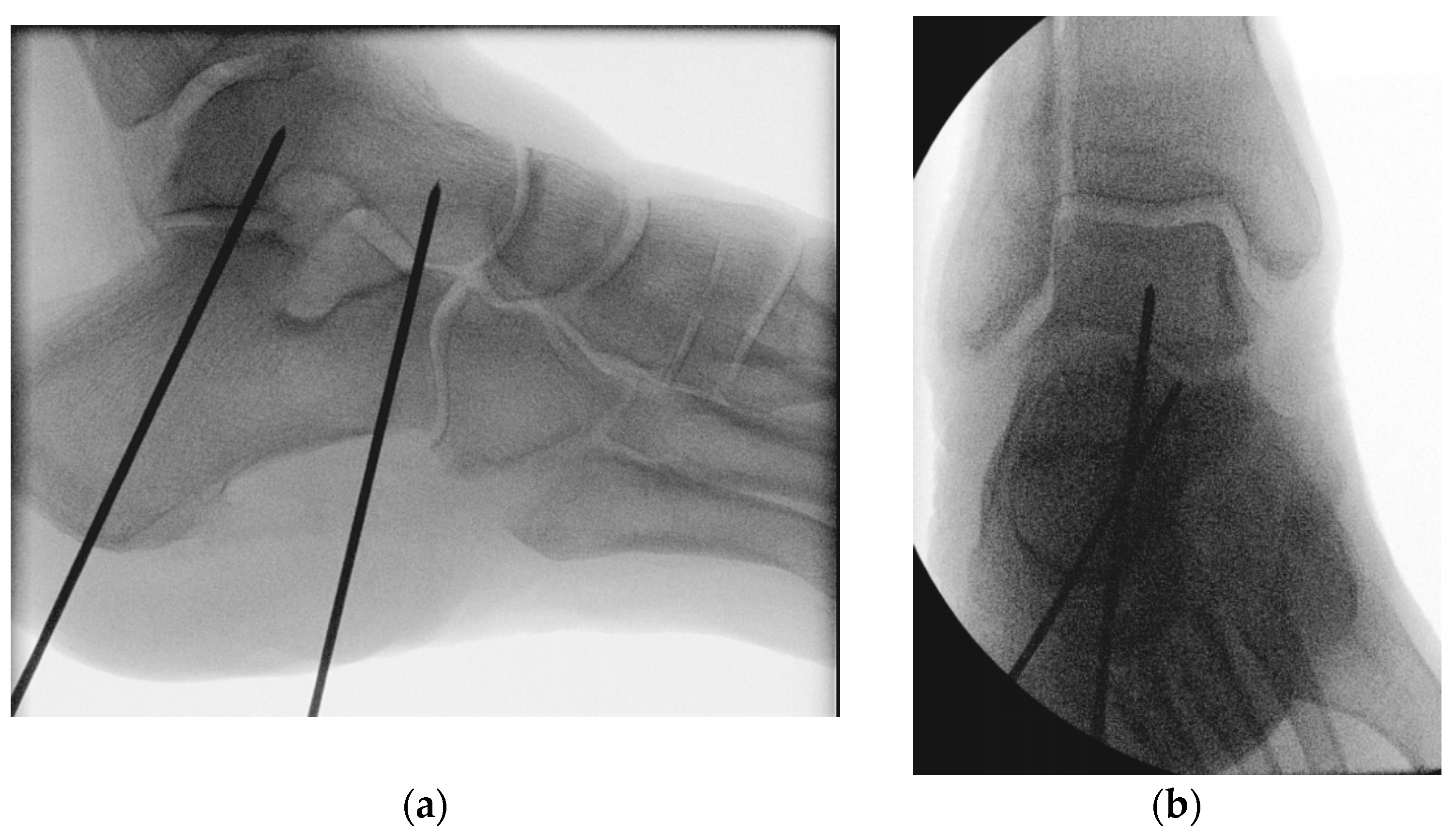
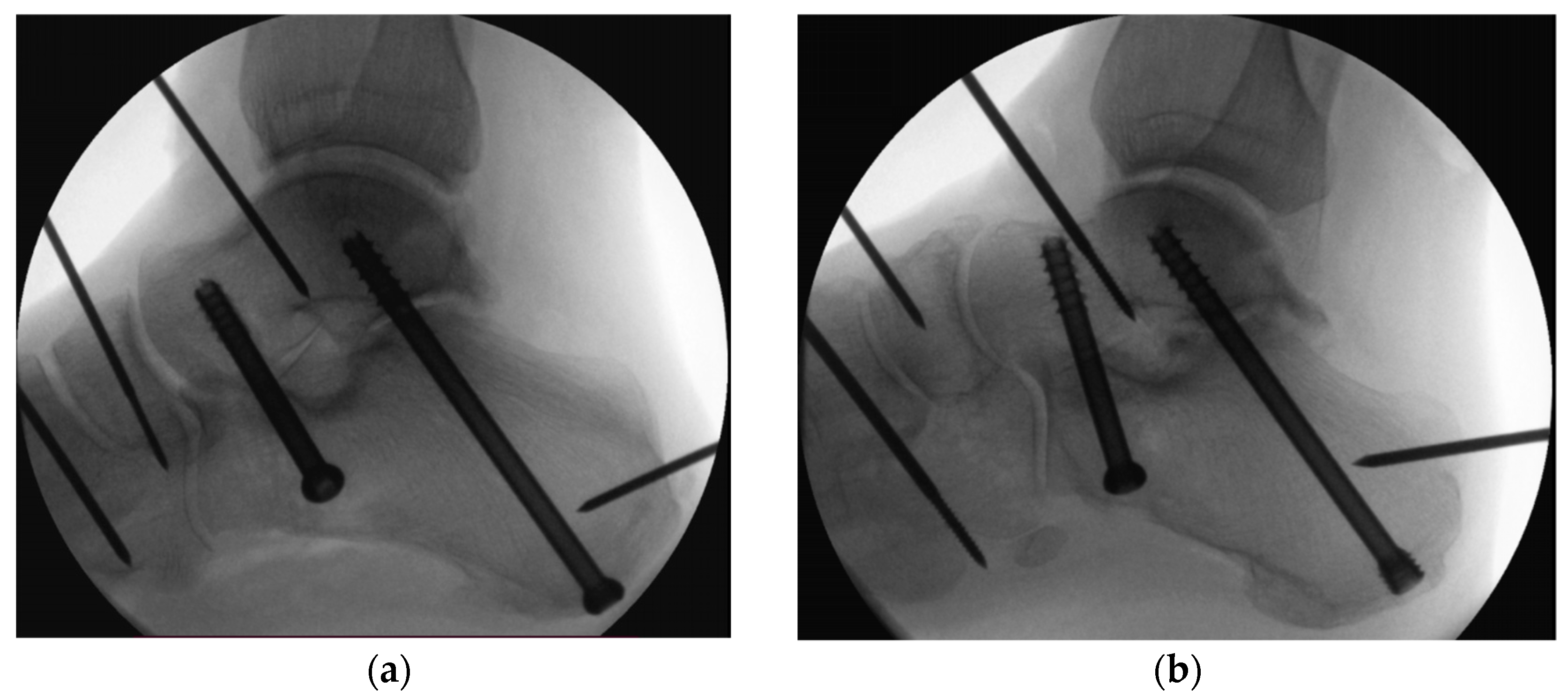
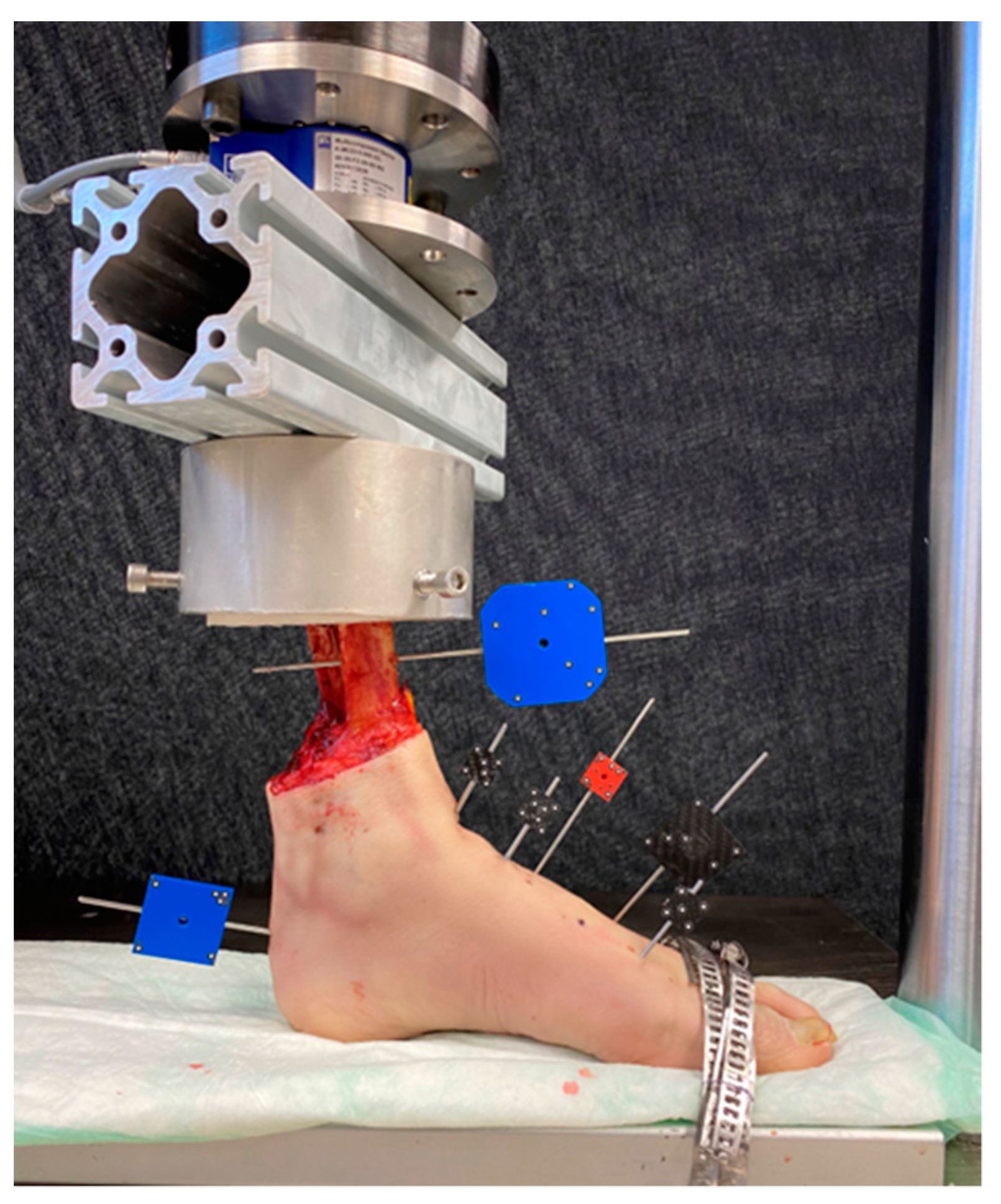
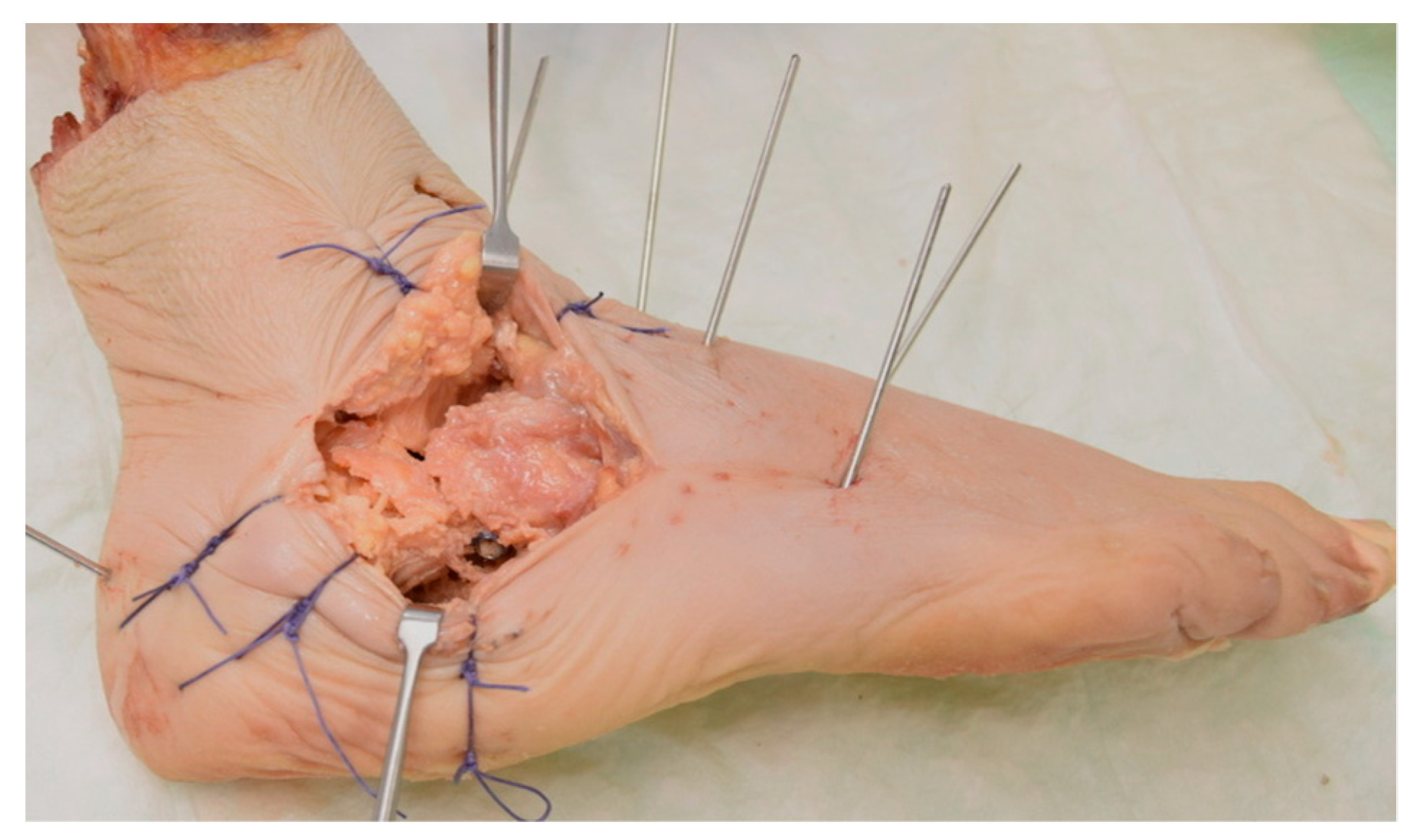
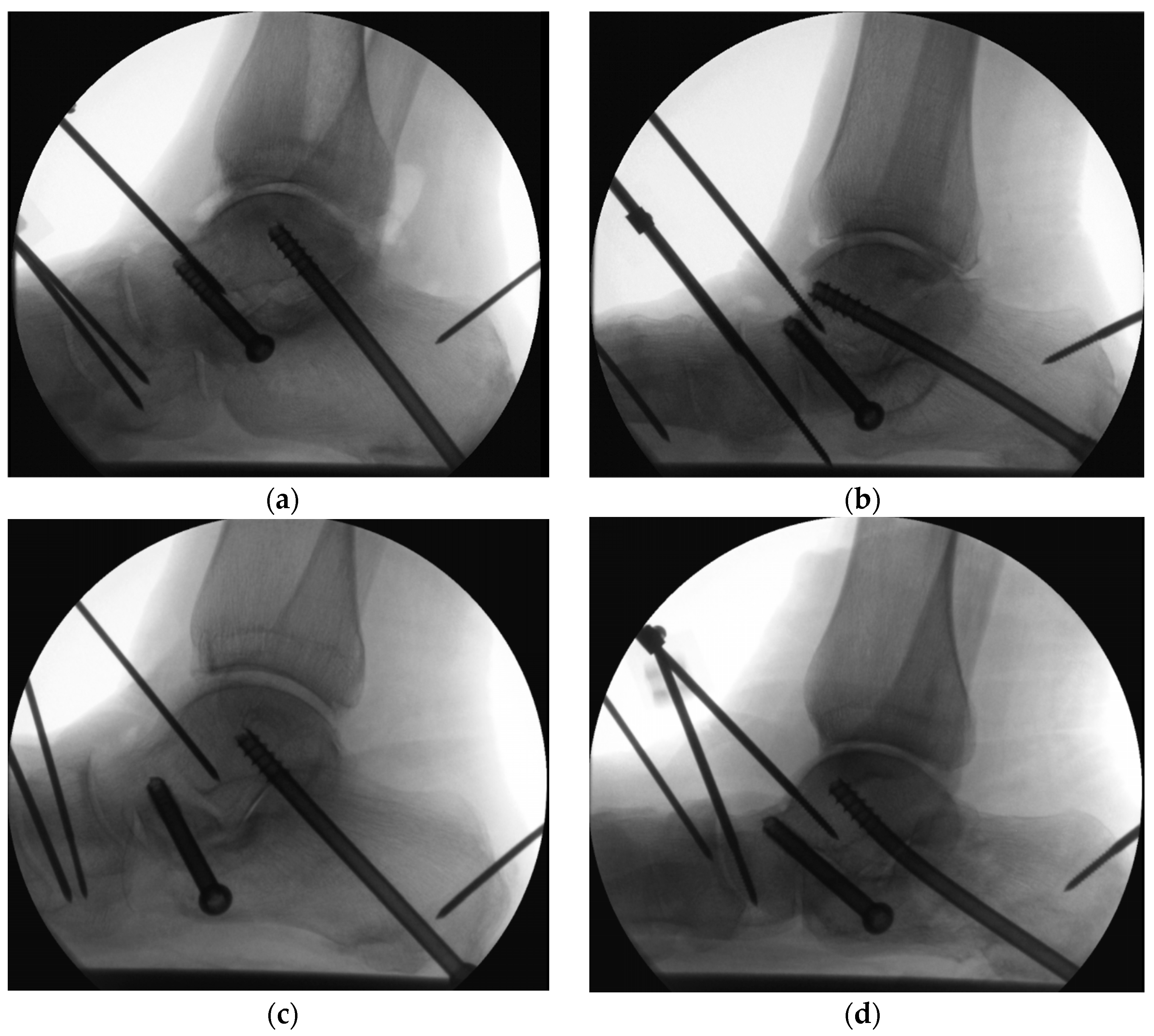
| Outcome | Group | Cycles | p-Value | ||||
|---|---|---|---|---|---|---|---|
| 2000 | 4000 | 6000 | 8000 | 10,000 | |||
| Varus–valgus [°] | 1 | 1.37 (0.75) | 2.89 (1.47) | 4.38 (2.31) | 6.34 (3.85) | 8.27 (5.00) | <0.001 |
| 2 | 0.96 (0.60) | 1.72 (1.14) | 2.48 (1.28) | 3.52 (1.91) | 5.29 (4.38) | ||
| Flexion–extension [°] | 1 | 0.65 (0.72) | 1.38 (0.80) | 2.45 (1.39) | 3.18 (1.52) | 4.82 (2.66) | 0.078 |
| 2 | 0.56 (0.64) | 1.00 (0.93) | 1.67 (1.28) | 2.77 (1.94) | 4.17 (3.07) | ||
| Internal–external rotation [°] | 1 | 0.51 (0.38) | 1.16 (1.10) | 1.87 (1.73) | 1.74 (1.30) | 2.46 (1.26) | 0.026 |
| 2 | 0.45 (0.70) | 0.69 (1.01) | 0.95 (1.21) | 1.42 (1.44) | 3.07 (2.68) | ||
| Displacement [mm] | 1 | 1.51 (0.94) | 3.02 (1.57) | 4.89 (2.72) | 6.89 (4.84) | 9.31 (5.36) | <0.001 |
| 2 | 0.86 (0.86) | 1.49 (1.26) | 2.30 (1.50) | 3.61 (2.22) | 6.81 (5.82) | ||
| Criterion | Group | Cycles to Failure | Failure Load | p-Value |
|---|---|---|---|---|
| 5° Varus–valgus | 1 | 9169 ± 5880 | 1117 ± 788 | 0.029 |
| 2 | 14,053 ± 6225 | 1605 ± 823 | ||
| 5° Flexion–extension | 1 | 10,368 ± 2643 | 1237 ± 464 | 0.179 |
| 2 | 13,539 ± 5696 | 1554 ± 770 | ||
| 5° Internal–external | 1 | 14,348 ± 3746 | 1635 ± 575 | 0.840 |
| 2 | 14,766 ± 4880 | 1678 ± 688 | ||
| Earliest failure | 1 | 8068 ± 3781 | 1007 ± 578 | 0.051 |
| 2 | 10,439 ± 2523 | 1244 ± 452 |
Disclaimer/Publisher’s Note: The statements, opinions and data contained in all publications are solely those of the individual author(s) and contributor(s) and not of MDPI and/or the editor(s). MDPI and/or the editor(s) disclaim responsibility for any injury to people or property resulting from any ideas, methods, instructions or products referred to in the content. |
© 2024 by the authors. Licensee MDPI, Basel, Switzerland. This article is an open access article distributed under the terms and conditions of the Creative Commons Attribution (CC BY) license (https://creativecommons.org/licenses/by/4.0/).
Share and Cite
Raykov, G.; Ivanov, S.; Gueorguiev, B.; Pastor, T.; Berk, T.; Pastor, T.; Zderic, I. Optimizing Subtalar Arthrodesis: A Human Cadaveric Evaluation of a Novel Partially-Threaded Screw Combination in the Delta Configuration. Medicina 2024, 60, 844. https://doi.org/10.3390/medicina60060844
Raykov G, Ivanov S, Gueorguiev B, Pastor T, Berk T, Pastor T, Zderic I. Optimizing Subtalar Arthrodesis: A Human Cadaveric Evaluation of a Novel Partially-Threaded Screw Combination in the Delta Configuration. Medicina. 2024; 60(6):844. https://doi.org/10.3390/medicina60060844
Chicago/Turabian StyleRaykov, Georgi, Stoyan Ivanov, Boyko Gueorguiev, Tatjana Pastor, Till Berk, Torsten Pastor, and Ivan Zderic. 2024. "Optimizing Subtalar Arthrodesis: A Human Cadaveric Evaluation of a Novel Partially-Threaded Screw Combination in the Delta Configuration" Medicina 60, no. 6: 844. https://doi.org/10.3390/medicina60060844
APA StyleRaykov, G., Ivanov, S., Gueorguiev, B., Pastor, T., Berk, T., Pastor, T., & Zderic, I. (2024). Optimizing Subtalar Arthrodesis: A Human Cadaveric Evaluation of a Novel Partially-Threaded Screw Combination in the Delta Configuration. Medicina, 60(6), 844. https://doi.org/10.3390/medicina60060844







